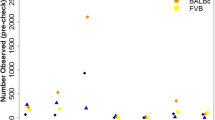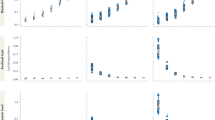Abstract
Inbred mouse strains provide the foundation for mouse genetics. By selecting for phenotypic features of interest, inbreeding drives genomic evolution and eliminates individual variation, while fixing certain sets of alleles that are responsible for the trait characteristics of the strain. Mouse strains 129Sv (129S5) and C57BL/6J, two of the most widely used inbred lines, diverged from common ancestors within the last century1,2,3,4,5, yet very little is known about the genomic differences between them. By comparative genomic hybridization and sequence analysis of 129S5 short insert libraries, we identified substantial structural variation, a complex fine-scale haplotype pattern with a continuous distribution of diversity blocks, and extensive nucleotide variation, including nonsynonymous coding SNPs and stop codons. Collectively, these genomic changes denote the level and direction of allele fixation that has occurred during inbreeding and provide a basis for defining what makes these mouse strains unique.
This is a preview of subscription content, access via your institution
Access options
Subscribe to this journal
Receive 12 print issues and online access
$209.00 per year
only $17.42 per issue
Buy this article
- Purchase on Springer Link
- Instant access to full article PDF
Prices may be subject to local taxes which are calculated during checkout



Similar content being viewed by others
References
Simpson, E.M. et al. Genetic variation among 129 substrains and its importance for targeted mutagenesis in mice. Nat. Genet. 16, 19–27 (1997).
Altman, P.L.K. & Katz, D.D. Part I, Mice and Rats. in Inbred and Genetically Defined Strains of Laboratory Animals 1–418 (Federation of the American Societies for Experimental Biology, Bethesda, Maryland, 1979).
Beck, J.A. et al. Genealogies of mouse inbred strains. Nat. Genet. 24, 23–25 (2000).
Silver, L.M. Mouse Genetics (Oxford Univ. Press, New York, 1995).
Bonhomme, F. et al. The polyphyletic origin of laboratory inbred mice and their rate of evolution. J. Linn. Soc 30, 51–88 (1987).
Stevens, L.C. A new inbred subline of mice (129-terSv) with a high incidence of spontaneous congenital testicular teratomas. J. Natl. Cancer Inst. 50, 235–242 (1973).
Auerbach, W. et al. Establishment and chimera analysis of 129/SvEv- and C57BL/6-derived mouse embryonic stem cell lines. Biotechniques 29, 1024–1028, 1030, 1032 (2000).
van der Weyden, L., Adams, D.J. & Bradley, A. Tools for targeted manipulation of the mouse genome. Physiol. Genomics 11, 133–164 (2002).
Levine, M. & Tjian, R. Transcription regulation and animal diversity. Nature 424, 147–151 (2003).
Force, A. et al. Preservation of duplicate genes by complementary, degenerative mutations. Genetics 151, 1531–1545 (1999).
Dermitzakis, E.T. & Clark, A.G. Differential selection after duplication in mammalian developmental genes. Mol Biol Evol 18, 557–562 (2001).
Eichler, E.E. & Sankoff, D. Structural dynamics of eukaryotic chromosome evolution. Science 301, 793–797 (2003).
Chung, Y.J. et al. A whole-genome mouse BAC microarray with 1-Mb resolution for analysis of DNA copy number changes by array comparative genomic hybridization. Genome Res. 14, 188–196 (2004).
Li, J. et al. Genomic segmental polymorphisms in inbred mouse strains. Nat. Genet. 36, 952–954 (2004).
Hughes, T.R. et al. Functional discovery via a compendium of expression profiles. Cell 102, 109–126 (2000).
Adams, D.J. et al. MICER—Mutagenic insertion and chromosome engineering resource. Nat. Genet. 36, 867–871 (2004).
Birney, E. et al. An overview of Ensembl. Genome Res. 14, 925–928 (2004).
Ning, Z., Cox, A.J. & Mullikin, J.C. SSAHA: a fast search method for large DNA databases. Genome Res. 11, 1725–1729 (2001).
Lindblad-Toh, K. et al. Large-scale discovery and genotyping of single-nucleotide polymorphisms in the mouse. Nat. Genet. 24, 381–386 (2000).
Wade, C.M. et al. The mosaic structure of variation in the laboratory mouse genome. Nature 420, 574–578 (2002).
Wiltshire, T. et al. Genome-wide single-nucleotide polymorphism analysis defines haplotype patterns in mouse. Proc. Natl. Acad. Sci. USA 100, 3380–3385 (2003).
Yalcin, B. et al. Unexpected complexity in the haplotypes of commonly used inbred strains of laboratory mice. Proc. Natl. Acad. Sci. USA 101, 9734–9739 (2004).
Frazer, K.A. et al. Segmental phylogenetic relationships of inbred mouse strains revealed by fine-scale analysis of sequence variation across 4.6 Mb of mouse genome. Genome Res. 14, 1493–1500 (2004).
Bernardi, G. The compositional evolution of vertebrate genomes. Gene 259, 31–43 (2000).
Aebi, M., Hornig, H., Padgett, R.A., Reiser, J. & Weissmann, C. Sequence requirements for splicing of higher eukaryotic nuclear pre-mRNA. Cell 47, 555–565 (1986).
Atweh, G.F., Anagnou, N.P., Shearin, J., Forget, B.G. & Kaufman, R.E. Beta-thalassemia resulting from a single nucleotide substitution in an acceptor splice site. Nucleic Acids Res. 13, 777–790 (1985).
Zeniou, M., Gattoni, R., Hanauer, A. & Stevenin, J. Delineation of the mechanisms of aberrant splicing caused by two unusual intronic mutations in the RSK2 gene involved in Coffin-Lowry syndrome. Nucleic Acids Res. 32, 1214–1223 (2004).
Zheng, B., Mills, A.A. & Bradley, A. A system for rapid generation of coat color-tagged knockouts and defined chromosomal rearrangements in mice. Nucleic Acids Res. 27, 2354–2360 (1999).
Acknowledgements
We thank B. Plumb and his team for sequencing; P. Biggs and members of the Sanger informatics team for their assistance; and W. Wang, L. van der Weyden, J. Jonkers and A. Velds for discussions. D.J.A. was supported by a CJ Martin Fellowship from the Australian National Health and Medical Research Council. This work was supported by the Wellcome Trust.
Author information
Authors and Affiliations
Corresponding author
Ethics declarations
Competing interests
The authors declare no competing financial interests.
Supplementary information
Supplementary Table 1
Comparative genomic hybridisation of C57BL/6J and 129S5 genomes. (XLS 672 kb)
Supplementary Table 2
SNPs from this study that correspond to entries in dbSNP. (XLS 292 kb)
Supplementary Table 3
Synonymous and non- synonymous coding changes and stop codons. (XLS 547 kb)
Rights and permissions
About this article
Cite this article
Adams, D., Dermitzakis, E., Cox, T. et al. Complex haplotypes, copy number polymorphisms and coding variation in two recently divergent mouse strains. Nat Genet 37, 532–536 (2005). https://doi.org/10.1038/ng1551
Received:
Accepted:
Published:
Issue Date:
DOI: https://doi.org/10.1038/ng1551
This article is cited by
-
Genomic structure of nucleotide diversity among Lyon rat models of metabolic syndrome
BMC Genomics (2014)
-
The landscape of inherited and de novo copy number variants in a plasmodium falciparum genetic cross
BMC Genomics (2011)
-
Increased susceptibility of 129SvEvBrd mice to IgE-Mast cell mediated anaphylaxis
BMC Immunology (2011)
-
An initial comparative map of copy number variations in the goat (Capra hircus) genome
BMC Genomics (2010)
-
Deficiencies in the region syntenic to human 21q22.3 cause cognitive deficits in mice
Mammalian Genome (2010)



